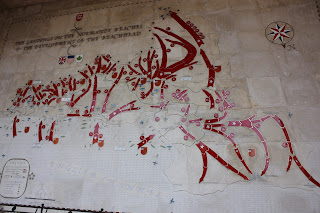Drive through the French countryside anytime during April - June and you will see beautiful fields of vibrant yellow. I love to garden, so I love knowing what I'm looking at as I pass by. Turns out that these are fields of rapeseed (or colza). I haven't done extensive research, but rapeseed is part of the mustard family and can be used in Biofuel. There is also a variety, I'm told, that is used to produce Canola oil.
On many of our drives, David and I have noticed what look like enormous nests in the trees. We finally asked one of our French friends and found out these are not nests at all. In French, they are called "gui"(pronounced "gee" with a hard "g").....which is mistletoe!!
Mistletoe is a parasite! It attaches itself to trees, plants and shrubs, stealing their nutrients and water.
The last little tidbit that I will share regarding our experience with driving in France involves the motorcyclists. If you are in the city, you can expect that scooters and motorcycles will bypass you as you wait at a stop light, moving right up to the front of the line of stopped cars. It's maddening.
What's worse, however, is that when you are in slow traffic on the highways, they just take matters into their own hands.....the white line becomes a "motorcycle lane". Heaven forbid you drive "too close" to that dashed line....you will get yelled at. Yes, I am totally serious, they are breaking the law, but they are totally indignant while doing so.
There were 5 D-Day assault beaches that the allied forces invaded in June of 1944. American troops landed on Omaha and Utah Beach, British troops landed on Sword and Gold Beach and Canadian troops landed on Juno Beach. But, did you know how these 5 beaches came to be known by their new code names? (They were formerly known by the French villages they bordered)
American General Omar Bradley had two staff sergeants working with him during the planning of the invasion. He asked these two sergeants where they were from. One answered Omaha and the other, Utah. The three beaches that were under British and Canadian command were code-named Goldfish, Swordfish and Jellyfish by a British commander. The Brits shortened the names of their beaches to Gold and Sword, but the Canadians didn't like the name Jellyfish (or it's shortened version, Jelly), so the Canadian commander named the 5th beach after his wife June, Juno.
In the words of Paul Harvey, "and that's the rest of the story". I'm not sure if this is fact or just a fun story from our guide, but it certainly helps me to remember the names of the 5 beaches.
 |
| Omaha Beach from the sea |
 |
| At the American Cemetery....graph of the D-Day invasion |
 |
| Walls of the Missing |
How fortunate David and I are to be able to visit these places that have been etched into history. How blessed we Americans are that so many have bravely and unselfishly fought, and continue to fight to secure our freedoms. Thank you for your sacrifice.
While the time between my blog posts might be longer, I continue to learn new things all the time. Stay tuned...next blog I plan to share with you about the small rodent that eats through engine lines and the shower museum!! It's another holiday weekend here, so we are setting off to Budapest, Hungary. Until next time!









Wow sis!!! It's so much better when you can be right in the middle of what you are learning! I'm a "hands on learner" I can't read a book and look at pictures to keep me interested.
ReplyDeleteYou should be a teacher!! You have been able to go out and see the things that the kids need to know about. Your (future) grandkids are going to be so amazed at all the history their granny knows!!! (ha ha~ guess I shouldn't go too far into the future!)
Thanks so much for sharing!!! Not only amazing pictures but a piece of history has been learned!
I love you!!!
Great post, Teresa! I am glad you saw Normandy and what's more, you wrote it all down. Miss you! Joyce DeWeese
ReplyDelete